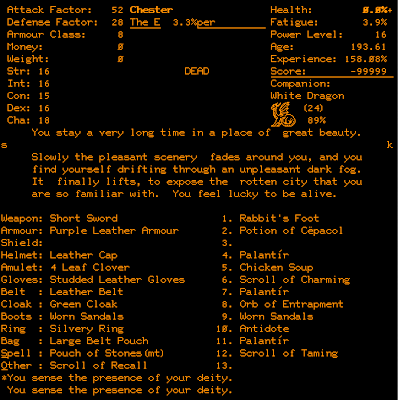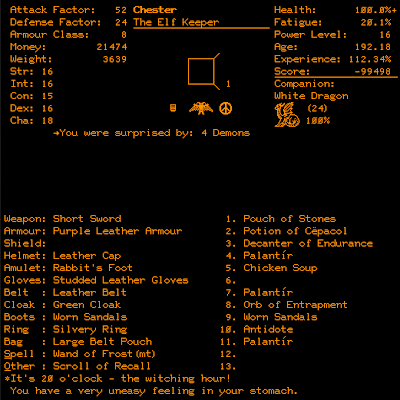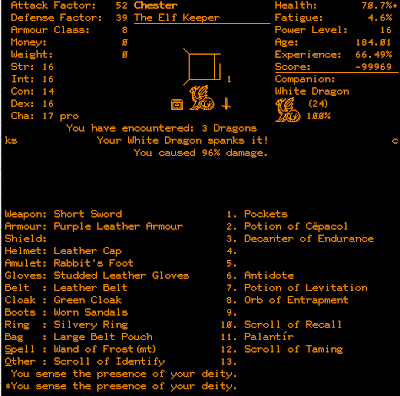From The CRPG Addict
I thought it was time for an update on
Camelot even though I don’t have much to report. It remains a hard game, made only slightly easier by very favorable resurrection odds when you die. I haven’t lost a character permanently in ages, although I have lost attributes and my score hovers at the game minimum, which is -99,999. I keep expecting to “get over the hump,” but now my thinking is that the metaphor is wrong and I’m not facing a “hump” so much as a long, slow, technical mountain climb that only gets harder.
 |
| The resurrection paragraph. I always breathe a sigh of relief when it doesn’t include language to suggest I’ve lost an attribute. |
I’ve gotten to Level 16, which feels pretty powerful, but there’s never a time that you don’t have to be careful. Even when you can destroy them with barely a pause, green slimes can still eat through your weapon and destroy it, messing up your odds against more difficult creatures. Items that you find post-combat can still be cursed, replacing good items in your inventory that you were counting on. I lost my shield and a Wand of Frost to careless item grabs.
Even though my second account allows me to see my position on an auto-map, I’ve continued to make my own maps, mostly because the auto-map doesn’t annotate secret doors, traps, chutes, or teleporters. These are becoming more common as I descend. Level 3 had a teleporter that took me to Level 7, which will be handy later on when I’m actually ready to visit Level 7.
My primary problem is large parties of monsters. A worst-case scenario might be stumbling into a room with a party of 6 demons and having them surprise me. Each gets a whack at me and each does 20% damage. I have no way to escape while they’re attacking, and I die. An only slightly-better scenario is stumbling into the same room and
not having them surprise me, but I don’t realize how dangerous they are, I make an attack, and
then they kill me during their turn.
 |
| Fortunately, these demons are friendly; otherwise, their “surprise” would have killed me in the first round. |
Usually, when facing a difficult party, I hope to kill one of them, then flee the room to heal before taking on the rest. A third problem is when I encounter those 6 demons, attack, get my health reduced to 20% on the follow-up, and then accidentally hit another attack key (or any other key) instead of fleeing the room, and the monsters kill me in the next round.
Monster difficulty seems to practically double between levels. I might do 73% damage, with a 60% chance to hit, for the average monster that I meet on Level 3, but that drops to 23% damage with a 25% chance to hit on Level 4. To advance to the next level, I need to kill a theurgist, but every time I consult a palantir, it tells me that the nearest theurgist is on Level 4 or below, and every time I head down that far, I die.
 |
| The palantir tells me the level of my next quest. |
The reset of the dungeon every hour, on the hour, creates some unique challenges. I try to keep the shortest paths between levels clear, but there are certain monsters that I loathe to fight, such as slimes and thieves, because of what they can do to your equipment and wealth, so some hours I have to decide whether to risk it or just wait for the next hour. There’s a special treasure room (with much harder enemies) on each level that’s worth a visit when it resets, although my character is still regularly killed by the denizens of that room on Level 1. In general, you have to keep your eye on the time because you don’t want to get caught in the middle of a level, thinking you’ve already cleared it, when the clock turns.
The other day, I complained a bit to creator Joshua Tabin. He looked at my character and suggested a few things, although most of them are more complex than he suggested. For instance, among his suggestions were:
1. My elf is supposed to be more of a spellcaster than a fighter, and I seem to be relying on melee combat. This is true, but you can only equip one spell item at a time, it runs out of charges quite fast, and it costs a lot of money to get it recharged. Plus, it’s vulnerable to being replaced by a cursed item. (When you pick up a cursed item, it automatically equips, replacing what was in the slot before it.) I had a Wand of Frost for a while that was massacring large groups–but it cost almost 20,000 gold pieces to recharge every half dozen uses.
2. I should make more use of Scrolls of Identification. You can use these any time. If you’re in an empty room, they tell you something about the room. If you’re in combat, they tell you about the monsters. If you’re about to pick up an item, they tell you what it is (and whether it’s cursed). Enormously handy, yes, but they don’t grow on trees. I use them when I have them but I don’t have them a lot of the time.
3. My equipment isn’t good enough. I agree, but it’s not like I can will new stuff into existence. The prices at the shop deter me from purchases since I need most of my money for level-ups. Because of the lack of Scrolls of Identification, I take a chance on unknown items sometimes to my woe. I lost a second suit of mithril mail this way and a good pair of boots.
4.
I should have a companion. No argument there. I have had one for most of the last 8-10 hours (although I didn’t when Joshua made the suggestion). I had a pseudo-dragon for several hours. When it died, I cycled through a series of them before getting a white dragon, which remained with me for about three hours before it “got bored” and left. I just had a bulette die in combat against some great orcs, and I soon replaced him with an “iron cobra,” who so far has been awesome. Companions are converted to your side with Scrolls of Taming, Orbs of Entrapment, and Charming Scrolls, and I forget a lot what item works on what type of creature.
 |
| My white dragon helps me against a group of dragons. |
5.
I’m not negotiating enough. Every level has some rooms with monsters guarding treasure chests. In many cases, the monsters will depart for a negotiated fee, and the chest is yours for the taking, and very often the price to get the monsters to leave is a lot less than the chest is worth. I’ve been largely operating via a classic RPG mentality of “clearing” every room even if the monsters are initially friendly.
Despite my “counters” to each of Joshua’s suggestions, a common theme emerges from them, which is the need to explore the dungeon strategically instead of methodically. The typical RPG encourages you to clear out every room on every level, and by the time you get to the end of the level, your character has improved enough to go on to the next one. That type of exploration is counter-productive in Camelot. What you want to do instead is to identify the special rooms on each level that have higher-level treasure and otherwise scout levels for the best treasures (distinguishable by icon) rather than insisting on hitting every square. Fight when necessary, not because you feel like you must. This is a difficult way for me to play. I’m not a so-called “completionist” who insists on hitting every corner of every level, but the idea of leaving enemies in my backpath is still anathema to the normal way I play.
I’ll keep Camelot on the active board for a while longer and hope my luck turns. If nothing else, it’s a good game to have going while your wife insists on watching The Muppet Christmas Carol for the 25th time.
Time so far: 28 hours
Original URL: http://crpgaddict.blogspot.com/2019/12/camelot-thats-how-conditions-are.html




